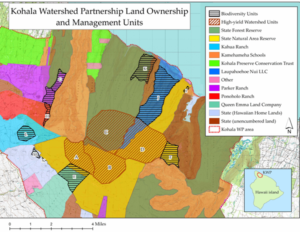It is estimated that half of Hawai‘i’s forests have been lost to deforestation, with the remainder threatened by non-native plants and animals. Our stewardship team maintains fenced preserves, manages feral ungulates, controls invasive plants, and restores native forests in an effort to protect essential ecosystem services, including the capture of rainwater, sediment mitigation, and groundwater recharge. These actions ensure that both native ecosystems and human communities in North Hawai‘i have an abundant supply of fresh water, and protect downslope coastal ecosystems from the detrimental effects of land-based pollution.
History
 In 2001, the major private landowners and public land managers of Kohala Mountain began discussions to address watershed management and conservation on a landscape scale rather than a property-specific basis. Following the precedent of eight other watershed partnerships across the state (together forming the Hawaiʻi Association of Watershed Partnerships), the Kohala Watershed Partnership (KWP) was formed by a Memorandum of Understanding in 2003, with nine land-owning partners and two associate partners, covering a total land area of more than 65,000 acres.
In 2001, the major private landowners and public land managers of Kohala Mountain began discussions to address watershed management and conservation on a landscape scale rather than a property-specific basis. Following the precedent of eight other watershed partnerships across the state (together forming the Hawaiʻi Association of Watershed Partnerships), the Kohala Watershed Partnership (KWP) was formed by a Memorandum of Understanding in 2003, with nine land-owning partners and two associate partners, covering a total land area of more than 65,000 acres.
In the years following its formation, KWP authored a watershed management plan, which defined actions for addressing threats to the watershed while preserving its biological, cultural, and economic resources. The creation of this plan involved input from landowners, conservation groups like The Nature Conservancy, state land managers, and public users, including hunters and hikers. The management plan underwent an Environmental Assessment with the State of Hawai’i Department of Land and Natural Resources, with a Finding of No Significant Impact (FONSI) published in December 2008.
Current Structure and Funding
 As of January 1, 2021, The Kohala Center is no longer the fiscal agent for KWP. Our stewardship team continues to engage in watershed and ecosystem protection, restoration, and management projects in Kohala Mountainʻs cloud forests and Ahupua‘a ‘o Kawaihae in collaboration with funders and community partners.
As of January 1, 2021, The Kohala Center is no longer the fiscal agent for KWP. Our stewardship team continues to engage in watershed and ecosystem protection, restoration, and management projects in Kohala Mountainʻs cloud forests and Ahupua‘a ‘o Kawaihae in collaboration with funders and community partners.

